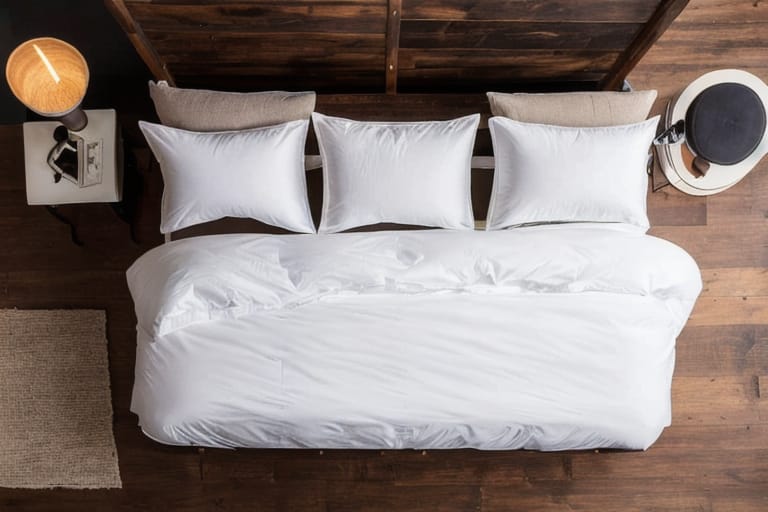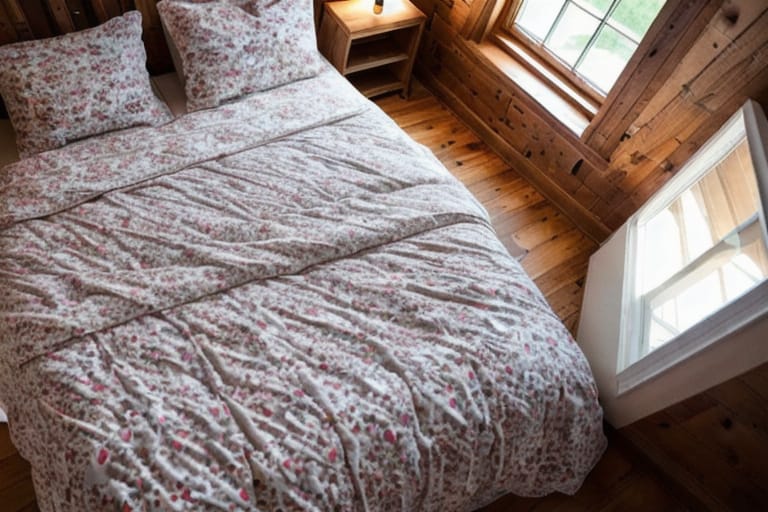Down comforters are known for being incredibly warm, soft, and comfortable to snuggle up under. But one question many shoppers have is: are down comforters heavy?
The short answer is – it depends! Down comforters can range from lightweight to quite heavy, with many factors influencing their fill weights.
In this beginner’s guide, we’ll cover everything you need to know about down comforter heaviness and help you find the perfect lofty, fluffy comforter for your needs.
What Is a Down Comforter?
Before diving into weights and fill power, let’s start with the basics – what exactly is a down comforter?
- A down comforter is a bedding item filled with down, which is the light, fluffy clusters of feathers found underneath the tougher exterior feathers of ducks and geese.
- Down fill power refers to the loft and insulation quality of the down. Higher numbers like 600 or 700+ mean higher quality down that provides more warmth for its weight.
- Down comforters have an outer covering typically made from lightweight fabrics like cotton, cotton sateen, or polyester microfiber with a high thread count for softness.
- When sewn into a comforter, down creates that marshmallow-like fluffiness, enhanced by baffle boxes that prevent fill from shifting.
Down Weight and How It Affects Warmth
So what determines whether a down comforter is heavy or light? Two key factors:
- Fill weight – total amount of down fill inside measured in ounces or grams
- Fill power – indicates the loft and insulation quality of the fill
Let’s break down how each impacts a comforter’s weight and warmth:
Fill Weight
As you may expect, fill weight directly correlates with the overall weight and warmth level of the comforter.
- Lightweight down comforters have fill weights below 600 fill power ounces. They usually range from 300 to 600 fill ounces.
- Midweight/All-season comforters have fill weights from 600 to 800 ounces.
- Heavyweight comforters designed for cold winter climates are 800+ fill ounces. Some can reach up to 1,200 ounces!
So if warmness is your main priority, choosing a heavyweight comforter packed with plenty of down is the way to go. Although the higher fill, the heavier it will be.
Fill Power
Fill power measures the loft and quality of the goose or duck down used. Numbers range from about 300 to 900+.
- Low fill powers (~300-500) use lower grade down and feathers. The fills are heavier and don’t insulate as well.
- Mid fill powers (600-700) come from mature geese and ducks. This down provides the best balance of warmth and lightweight feel.
- High fill power (800-900+) uses the highest grade of goose down. It’s extremely lofty, lightweight, and insulating.
So higher fill powers provide more warmth for less weight. A lighter 600 fill comforter can feel just as cozy as a heavier, bulkier one!

Finding the Right Comforter Weight
When choosing a down comforter, you’ll want to find the right balance of warmth and weight for your needs. Here are key factors to consider:
1. Climate Conditions
Do you live in a warmer or colder region of the country? Light, summer-weight comforters work nicely for hot southern climates where the AC is on low most nights. For cold northern winters where it snows, a heavy, ultra-warm down comforter helps you snuggle comfortably.
Midweight all-season comforters around 600-700 fill are versatile for fluctuating spring and fall temperatures.
2. Sleep Preferences
Do you sleep hot or run cold at night? Do you like lots of blankets or few? If you kick off covers quickly, choose lower fill weights marked “Lightweight” or “Summer”. If you bundle up year-round, pick a toasty, heavy-weight winter comforter rated to 20°F or lower. Also factor in if you share the bed with a partner.
3. Bed Size
The cut and dimensions impact fill weight too. King size and California King comforters require more down fill to cover the expanded surface area evenly. Expect king sizes to use 10-20% more fill ounces than a queen or full size.
Top-Rated Down Comforters by Weight
Now that you know how fill power, climate, and bed size impact down comforter weights, here are some top-rated picks across the lightweight, middleweight and heavyweight spectrums:
| Weight Class | Product | Bed Sizes | Fill Weight | Loft | Price |
|---|---|---|---|---|---|
| Lightweight | Egyptian Cotton Down Comforter by Beverly Fine Linens | Twin, Queen, King | 300-400 oz. | Medium | |
| All-Season | White Goose Down Comforter by Pacific Coast | Twin, Full Queen, King Cal King | 600 oz. (Queen) | High | |
| Heavy/Extra-Warm | Ultralight Warmth Down Comforter by Buffy | Queen | 700 oz. | Ultra-High |
As you can see, there is quite a range in fill weights and prices depending on warmth level and quality. But no matter if you pick lightweight or heavyweight, USA made, European import, or budget option, following our down comforter buying guide ensures you select the perfect toasty, comfortable year-round blanket!

FAQs About Down Comforter Warmth & Weight
We’ll leave you with answers to some frequently asked questions about balancing warmth, weight and quality in your dream down comforter:
Are down comforters very heavy?
Not necessarily! Thanks to high loft materials like goose down, they can provide serious warmth without the weight. Light and medium options work year-round. Heavy-weight down comforters 30+ ounces do have more heft but also more insulation for freezing temps.
Should I get a lighter or heavier comforter based on my local climate?
Yes, absolutely choose fill weight based on your climate for ideal comfort! Those in southern, warm climates do well with lightweight 300-400 oz comforters used summer and on cool nights. Cold northern regions need heavyweight 700-1,200 oz comforters to stay cozy under.
How much does fill power impact warmth versus weight?
Great question! Fill power has a big influence – higher numbers like 700-900+ mean down clusters trap more body heat without adding weight. 600-fill will be warmer ounce per ounce than 500-fill. Prioritize fill power over high fill weights for toasty yet lightweight bedding.
What’s the warmest down comforter fill I can buy?
For maximum warmth rated to sub-zero temperatures, look for options with at least 800+ fill power and over 900 fill ounces. European white goose down around 700-900 fill power offers the best warmth-to-weight ratio for frigid conditions.








